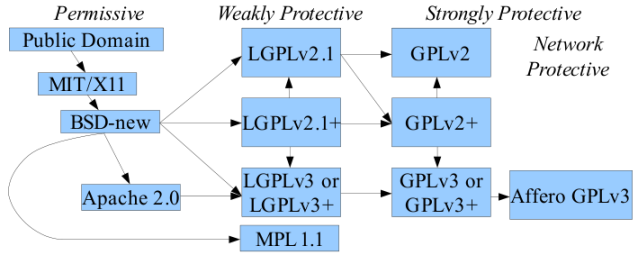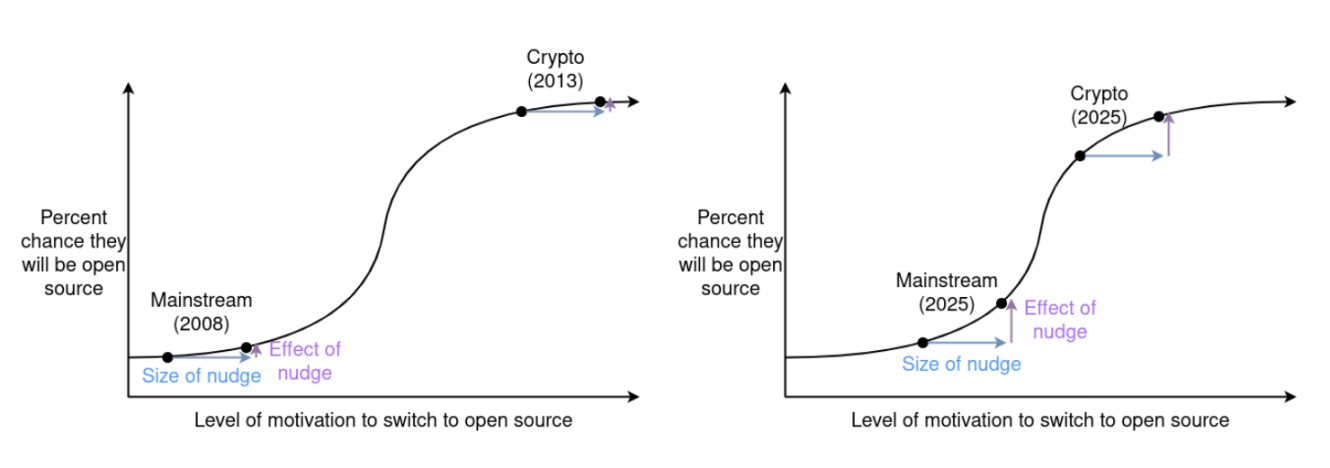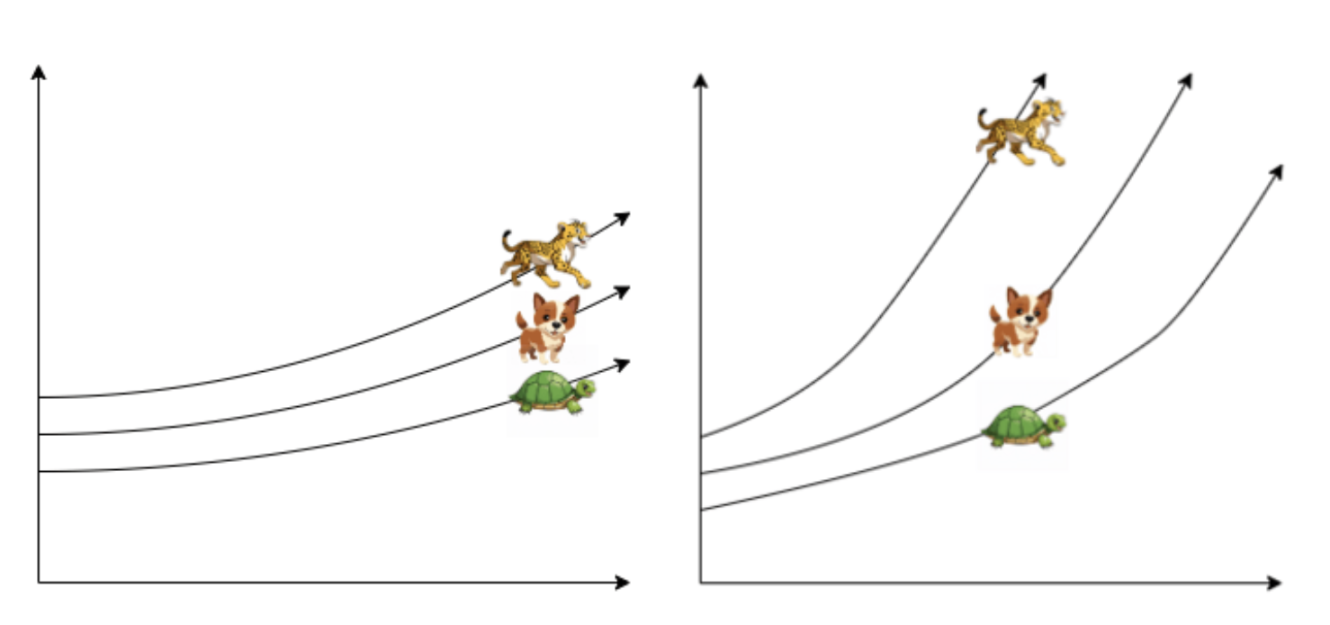Vitalik: When open source becomes mainstream, why do I abandon permissive licensing and embrace copyleft?
In the world of free and open-source software—and, more broadly, free content—copyright licenses generally fall into two major categories:
- If content is published under a permissive license (such as CC0 or MIT), anyone can access, use, and redistribute the content without limitation, provided they comply with minimal requirements like proper attribution.
- If content is released under a copyleft license (such as CC-BY-SA or GPL), anyone may also access, use, and redistribute copies freely. However, if they create and distribute derivative works by modifying or combining the original with other works, they must release those new works under the same license. Additionally, the GPL mandates that all derivative works disclose their source code and fulfill several other obligations.
In summary: permissive licenses enable unrestricted sharing with the public, while copyleft licenses only allow sharing with those who are equally committed to open sharing.
Since childhood, I have been both an enthusiast and a developer of free and open-source software and free content, passionate about creating tools and resources I believe will benefit others. Previously, I preferred permissive licensing (for instance, my blog uses the WTFPL license); however, I have recently started to lean towards the copyleft model. This article outlines why my perspective has shifted.

The WTFPL license represents one interpretation of software freedom, but it’s far from the only approach.
Why I Used to Prefer Permissive Licenses
Initially, my goal was to maximize the adoption and reach of my work, and permissive licenses clearly state that anyone can create derivative works without worrying about restrictions, making them ideal for this purpose. Most businesses are hesitant to open source their projects for free, and I recognize that I can’t force them to fully embrace the free software movement. My intention was to avoid unnecessary conflict with their established practices.
On a philosophical level, I’ve always been opposed to copyright (and patents). I reject the notion that two individuals privately sharing fragments of data can be considered criminal with respect to a third party. They neither interact with nor deprive the third party of anything (after all, “not paying” is not equivalent to “stealing”). For a variety of legal reasons, explicitly placing works in the public domain is often complex in practice. Permissive licenses, therefore, are the purest and safest means to approximate a “no copyright claims” stance.
I do admire the “fight copyright with copyright” concept behind copyleft and consider it a clever legal innovation. In some respects, this mirrors the liberal philosophy I hold in high regard. As a political doctrine, liberalism is often seen as prohibiting the use of violence except to protect people from harm. As a social principle, I view it as a way to civilize our innate aversion to harm, by treating freedom as a sacred value and making infringements upon freedom inherently objectionable. Even if you’re uncomfortable with others’ voluntary, unconventional relationships, you can’t interfere—intervening in the private lives of free individuals is itself offensive. Thus, as a matter of principle, there are historical precedents that show distaste for copyright and the “use of copyright against copyright” can coexist.
However, while copyleft for literary works fits this minimalist notion of “using copyright against copyright,” the GPL’s requirements for software source code go beyond it: they employ copyright to aggressively mandate disclosure of source code. Although this serves the public interest rather than mere licensing profits, it’s still an assertive application of copyright. For even stricter licenses such as the AGPL, this goes further: even if a derivative work is only accessible via Software-as-a-Service (SaaS) and never publicly released, source code disclosure is still required.

Different open-source licenses impose different source code sharing obligations on derivative works, with some demanding disclosure in a wide range of situations.
Why I Now Favor Copyleft
My move from permissive to copyleft licensing is rooted in two major changes in the industry and a shift in my philosophical thinking.
First, open source has become mainstream, making it more practical to encourage companies to go open source. Today, leading tech companies—including Google, Microsoft, Huawei, and others—not only embrace open source, but actively drive the development of open-source software. In emerging areas like artificial intelligence and cryptocurrency, dependency on open source now surpasses that of any previous sector.
Second, competition in crypto is becoming more intense and profit-driven. We can’t rely on developers to open source simply from goodwill anymore. Promoting open source now depends not just on ethical appeals (“please open your code”) but on the “hard constraints” of copyleft, which limit code access to developers who also share their work as open source.
If we visualize how these forces increase the value of copyleft, it might look like this:

In an environment where open source isn’t entirely infeasible or inevitable, incentives for open source have the greatest impact. Today’s enterprise and crypto industries fit this profile, making copyleft’s role as an open source incentive much more significant than before.
(Note: The horizontal axis is the motivation to open source; the vertical represents the probability. The side-by-side charts show how copyleft now creates stronger synergies between motivation and adoption among mainstream organizations, while crypto’s maturing ecosystem yields diminishing marginal returns—demonstrating how copyleft’s rationale evolves with industry changes.)
Third, economic theories such as those advanced by Glen Weyl have convinced me that where superlinear returns to scale exist, the optimal policy isn’t a hard property-rights regime as in Rothbard/Mises, but rather one that proactively promotes more openness than would occur naturally.
Put simply, if economies of scale exist, basic math tells us that a lack of openness inevitably leads to dominance by a single actor. Economies of scale mean that if I control twice as many resources as you, my gains will exceed twice yours. By next year, I’ll have 2.02 times your resources, and over time, the gap only grows—

Left: In proportional growth, small initial disparities remain minor; Right: With economies of scale, even small initial disparities quickly widen over time.
Historically, the crucial check on runaway imbalance has been the inexorable spread of progress. As talent moves across companies and countries, so do ideas and skills; poorer countries catch up through trade; industrial espionage ensures innovation can’t be monopolized forever.
Recently, however, several trends are undermining these safeguards and weakening the forces that historically balanced growth:
- Technological progress is accelerating at a super-exponential pace, with innovation cycles shorter than ever.
- Political instability is rising both within and among nations. If rights protections are robust, others’ progress poses less risk; but in volatile environments, power concentration becomes a real danger. At the same time, government appetite to regulate monopolies is waning.
- Modern software and hardware are more closed; unlike traditional products, which allowed reverse engineering and access to technology, proprietary products may now grant usage rights but keep modification and control tightly held.
- The natural limits on organizational scale are eroding: where management overhead and local demands once kept organizations in check, digital technologies now support unprecedented scale and control.
Combined, these trends are intensifying—and sometimes compounding—imbalances of power among firms and nations.
That’s why I increasingly believe we need stronger measures to proactively encourage or require the diffusion of technology.
Recent government policies across the globe can be seen as mandatory interventions to promote technology diffusion:
- The European Union’s standardization directives (e.g., mandatory USB-C adoption) are designed to dismantle closed ecosystems hostile to interoperability;
- China’s enforced technology transfer policies;
- U.S. bans on noncompete agreements (which I support, as they force companies to “partially open source” trade secrets through workforce mobility, since NDAs are often poorly enforced in practice).
To me, the main drawback of these policies stems from their state-imposed nature, which tends to prioritize forms of diffusion that align with local political or business interests. But the upside is real: these measures genuinely accelerate technology dissemination.
Copyleft, by contrast, builds a massive pool of code (or other creative works) that can only be used if you also make your derivatives open source. As such, copyleft acts as a highly universal and neutral technology diffusion incentive, achieving the benefits of the above government interventions—without many of their downsides. This neutrality arises because copyleft doesn’t favor any particular party, nor does it require central planners to tune parameters.
Of course, these conclusions aren’t absolute. In scenarios where “maximum spread” is the top priority, permissive licenses still have a role. But overall, the combined value of copyleft today far exceeds what it offered fifteen years ago. Projects that once chose permissive licensing should at least consider adopting copyleft now.

Regrettably, the current “open source” label has strayed far from its original meaning. Still, in the future, we may see open-source vehicles—and copyleft hardware could help make that vision a reality.
Disclaimer:
- This article is reprinted from Foresight News and copyright belongs to the original author Vitalik Buterin. If you have concerns about this republication, please contact the Gate Learn team, and the team will address your request promptly in accordance with established procedures.
- Disclaimer: The views and opinions expressed in this article are solely those of the author and do not constitute investment advice.
- Other language versions are translated by the Gate Learn team; do not reproduce, distribute, or plagiarize this translation unless Gate is clearly credited.
Related Articles

Solana Need L2s And Appchains?

The Future of Cross-Chain Bridges: Full-Chain Interoperability Becomes Inevitable, Liquidity Bridges Will Decline

Sui: How are users leveraging its speed, security, & scalability?

Navigating the Zero Knowledge Landscape

What is Tronscan and How Can You Use it in 2025?
